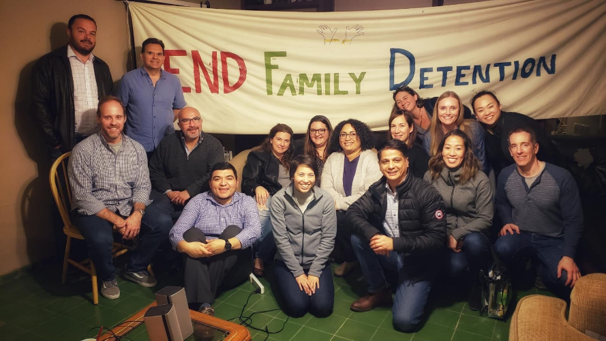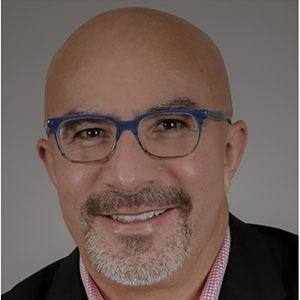Jorge Chavez
In February, fifteen Microsoft colleagues and I flew down to San Antonio, Texas, and drove southeast for about 90 minutes to Dilley, a small town situated 87 miles from Laredo and the border with Mexico. It is home of the South Texas Family Residential Center (STFRC), the largest detention facility in the United States for undocumented immigrant mothers and their children. The purpose of our trip was to volunteer at the STFRC for a week and offer legal assistance so that these women and their children could remain in the United States and be released from the facility. They would then submit their application for asylum to the US Immigration court system. Our work there was assigned and coordinated by the Dilley Pro Bono Project (DPBP), a small but impressive, idealistic and energetic group of lawyers, paralegals and legal assistants. We were not the first nor the last group of volunteers they coordinate with, and to put it in terms I’m sure they’d appreciate, “la lucha” for them continues.

Every detained mother’s story should and must be told, but out of respect for the pain they’ve endured and the legal case their lives have become, I cannot do so in a detailed manner. In many ways, the young people who make up DPBP have put their lives on hold. I hope someone tells their story because the world needs more of them. I will do my best to provide a glimpse of the wonderful work they do. I’m sure my fellow Microsoft colleagues will tell their own story, but I can only share what I saw, learned and experienced. In just a week, in the dusty town of Dilley, Texas, where the air carries a slight aroma of oil, and trailer trucks on their way to Canada or Mexico stop to gas up and refuel on coffee, I witnessed some of the best and the worst the United States has to offer.
STFRC sits about a mile away from the main highway on terrain that is completely flat so it’s easy to miss. The facility’s location is in fact easier to pinpoint at night thanks to its myriad of outdoor lights which could be mistaken for those of sports fields all over the United States. On our daily morning drive to the facility, we’d see an Immigration and Customs Enforcement (ICE) SUV parked on the side road which led to the facility, perhaps a cautionary reminder to family and friends, either visiting or picking up their loved ones, that ICE could be anywhere. A large prison run by the Texas Department of Criminal Justice stands between the highway and STFRC, so at first, we mistakenly thought this was the place we’d be working at. Their proximity serves as testimony that no other country in the world has the same high-level incarceration rates, or allows private companies to profit the way they do from imprisoning people, as the United States.
Our days were mostly spent at a large “Visitor’s Center” trailer (which served as central command for DPBP) where all group presentations and one-on-one interview prep meetings for detained mothers took place. It stood right next to the security trailer that visitors and employees passed through when we arrived and left the facility. We weren’t permitted to see or visit any other part of the facility except for the Asylum Officers’ offices, where interviews were being conducted. A few of my colleagues were quick to point out the irony of being greeted daily by a photograph hanging on one of the walls of the registration trailer of a smiling President Trump given his staunch anti-immigration views. This, of course, is standard practice in every government office, but its presence just heightened our commitment and sense of urgency to help women and children affected by his administration’s immigration policies. In all fairness, STFRC was built and assigned to be run by a private company during the Obama administration, although attempts to increase its size by the current one have, so far, been unsuccessful.
Statistics are hard to come by, but STFRC can hold approximately 2,400 women and children. Over the course of the week, we helped facilitate “Intake Charlas” (which are group chats and presentations DPBP gives all women recently admitted into the facility) for over 400 women picked up by ICE and who were now in expedited deportation proceedings. Since only mothers and their children can be detained at STFRC, at least 800 women and children (a conservative estimate) were admitted into STFRC just prior to us arriving and while we were there.
A legacy of fear and violence, along with the desire to give their children a better life, lies at the heart of every detained woman’s story. Many times, their agony grows along their way through Mexico and is exacerbated once they enter the United States. Most of the women we spoke with crossed the Rio Grande (aka Rio Bravo) and a few gave themselves up at a legal point of entry. The majority travelled in small groups, many with male family members, relatives and friends, whom they were separated from as soon as they were apprehended by ICE. Herein lies one of the most heinous aspects of the current administration’s immigration policies: Families are separated without any reassurance they’ll be reunited.
The first and most horrific memory these women will have of the United States, whether they are deported or allowed to remain in the country, is their time spent at a “perrera” or “hielera”, which literally translate into “doghouse” and “icebox” and whose purpose, it seems, is to strip them of their humanity. These are holding pens, and for all practical purposes they are jails and cages, where they are detained up to 72 hours, sometimes longer, at times with little food or no medical attention. Iceboxes are named so because the air conditioning is always at full blast. Women and children try to sleep and recover under the cold stream of relentless air, at best covered with a blanket like the ones runners get at the end of a marathon. When the time comes to leave and make room for a new group of detained immigrants, they are transported to facilities like the one at Dilley. Many of these immigrants are ill, malnourished, and exhausted, not due to a voyage of thousands of miles, but a few days in these medieval perreras and hieleras.
Our first interaction with the detained women and their children happened on Monday morning while they slowly and quietly lined up at the far entrance of the Visitor’s Center, the bright and fluorescent colors of their clothes contrasting against the monotone grayish, bluish color of the trailer. I couldn’t avoid thinking that the clothes and tennis shoes they were wearing were possibly nicer and more durable than what they had worn back home. On the other hand, jackets and sweatshirts were probably not required in many of their hometown’s warm weather. Once they entered the Visitor’s Center, they shuffled off to their assigned corresponding activity that they were scheduled for. This was usually an “Intake Charla”, a “Release Charla” or a Credible Fear Interview (CFI) prep meeting. If bright colors against a dull background were the canvas of the place, the sound of crying children, some in evident distress, was its soundtrack. We all had to deal with the fact many children were either too sick, too tired, or too scared to be left in the Visitor’s Center small playroom. The chance of any of us catching a cold, or something worse like chicken pox was always there, but this seemed a small risk to take.
Immigration law can be both daunting and disconcerting and it seems to be ever changing. Our main task, per DPBP, was to prepare women for an interview with an Asylum Officer (AO) called the “Credible Fear Interview” where they had to prove, according to stringent criteria, that a credible fear existed and thus they could not be immediately deported back to their home country. This fear is based upon the fact they’ve been or could continue being persecuted, or have suffered harm or could continue suffering harm due to something intrinsic to them they can’t change like their ethnicity, nationality, political opinion, etc. This persecution or harm could be death threats, sexual abuse, and other types of physical or emotional harm and persecution. Unfortunately, one’s sole desire of wanting a better life or a job do not qualify as valid reasons to be admitted into the country under an asylum claim. Most of the women we spoke with came from El Salvador, Guatemala and Honduras, places where gangs called “maras” like MS13 and Barrio 18 have turned their countries into a no man’s land. Regrettably, the police collude with them or abdicate their duty to protect life and property. Alcohol and drug use is rampant, employment opportunities are scarce, and domestic violence (including marital rape) are common occurrences. There are also women and children who have arrived from other Latin-American countries and even sub-Saharan Africa. Perhaps, a bit surprising, was the very low number of Mexican nationals in detention. While we were there, I personally heard of only one case, but I’m sure there were more.
My main responsibility was as a Spanish interpreter, so I teamed up with a few non-Spanish speaking colleagues, most of them lawyers, for CFI prep meetings. Some were as quick as 30 minutes while others lasted hours, with multiple breaks over two days. We couldn’t be satisfied until the “credible fear” was clearly established, and sometimes this was too difficult to determine or too painful for the woman to share. Sadly, we wrapped up a few prep meetings not feeling confident we had built a strong enough case. On our third day at Dilley, I had the opportunity to join one of the women we had worked with during her actual interview. I was there to take notes, offer moral support, and due to the nature of the proceeding and if the AO allowed it, correct the official interpreter or add to the established line of questioning. I’m ashamed to admit I was extremely nervous, and I felt I didn’t have the right to be. I also felt sympathy for the AO. I was left with the impression that she was very understanding and sympathetic and she tried her best to tease out all possible details in order to meet the necessary criteria. I believe she could’ve just accepted the woman’s answers at face value, but she often asked the same question in many ways and added several follow up questions. To my surprise, even though I knew it could be a possibility, she allowed me to ask a follow-up question to a fact the woman had stated before, and thus added information I believed she had forgotten from our CFI prep meeting. As I write this, I have no idea what her outcome was, but I pray it is a positive result.
There are multiple ways to portray why and what’s happening at Dilley in the worst possible terms, and justifiably so. Many people have already done this and will continue to do so. My instinct was to decry what I saw there, but every day I found a silver lining where I least expected to find one. On Sunday night, right after our arrival in Dilley, we took a crash course on what we’d be doing during the week. Although I had listened to speeches, read history books and I felt I had a decent understanding of the topic, the way the DPBP team talked about the rights all immigrants should have, really impressed me. Maybe I was already predisposed to be moved, but I couldn’t think of any other country where people would fight to defend the rights of those who weren’t even its citizens with so much energy and compassion. I found it remarkable the DPBP team could work within a facility whose existence they clearly opposed and who would do everything they legally could do to see it disappear. There are few countries where this would be possible. There was one moment when I almost teared up and had to stop interpreting for a few seconds because my voice was breaking up. This was when we were concluding one of the CFI preps, and the woman we were helping could not stop thanking God for having put us in her path. The power of faith was something I saw often that week.
On a personal level, the most impactful silver lining came while doing “Intake Charlas” which I monopolized to some extent and that I took very seriously. After doing the first charla, it dawned on me I was the first person who had addressed these women in a meaningful and positive way for a substantial amount of time since they had entered the United States, maybe even throughout their whole journey. The charla basically described what our purpose as DPBP and volunteers was, what they should expect over the subsequent days, and what ideally, we wanted to accomplish. I, an immigrant myself, had the responsibility and honor to welcome them into the United States in a humane, helping and caring manner. I had the privilege to be the first American to speak with them at length as a fellow human being, and not in English but in their own language. I believe I was able to get through and motivate them due to the questions, smiles, comments, and laughs I was able to get out of them. I’ve carried an American passport for a few years now and I’m grateful to live in my adoptive home, but when someone asks what I am, I say I’m Mexican. I was born in Mexico, grew up Mexican and will die being Mexican, but my experience in Dilley made me truly feel American for the first time.
Upon our departure, the DPBP team told us to be on the lookout for Dilley families at the airport who we’d easily identify thanks to their bright and fluorescent colored clothes. I sincerely hope they listened to the advice we provided throughout their unfortunate detention and especially during my charla. With deep and heartfelt admiration for everything they’d gone through to get to Dilley, I told these brave women that right after leaving the facility, their second most important task was to find a lawyer and start their asylum petition process, but that their first and most important task was to kiss their children and hug their relatives and friends who were eagerly waiting for them on this side of the river.

